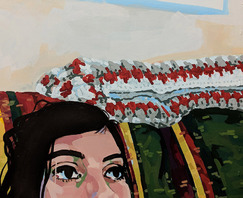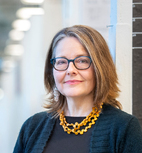
Academics . Painting . Courses
Painting Courses
Painting as System, Method, Organism + Concept
Course No. PTG 226 Credits: 3.0
This course examines the nature of Painting as it relates to other visual arts media. The creation of systems as a way to generate, organize, compose, pattern, plan, fashion, model, design, execute, and possibly destroy art work will be explored. Artists such as Sol Lewitt, Marcel Duchamp, Survival Research Laboratories, Vito Acconci, Fischli & Weiss, Chuck Close, Alfred Jensen, Jackson Pollock, and Mel Bochner will be examined within the context of how systems function within their work. Reading relevant texts, looking at work, research/special projects, studio work, group and individual critiques are an integral part of this course. Students may work in the area of their expertise. Goals & Objectives: Students should understand the nature of the decision-making process in the creation of work, and establish analyzing and evaluating criteria. Prerequisites: PTG 221 or PTG 232 or with the permission of the instructor. 3 credits.
Popular Culture + Imagery
Course No. PTG 227 Credits: 3.0
This course will explore the symbiotic relationship of art and culture, and the particular ways in which popular and material culture influence the visual arts and vice versa NOW (if there are indeed any particular ways that stand out in this particular time as opposed to a different time in history). Students will learn to discern both the overt and covert affects/effects of culture on contemporary artists as well as on their own work and that of their peers. Students in order to take part in relevant classroom conversation/discussion need a working knowledge of current events/ history/popular culture and will need to be ready to read and do research, etc. Open to all Students. 3 credits.
Painting Beyond Observation
Course No. PTG 232 Credits: 3.0
Continued emphasis on material, color, and skill-building. Students will work primarily with acrylic paint. This class moves beyond observational rendering and focuses on other approaches to developing content for work. Class topics focus on contemporary issues in Painting including: What makes a Contemporary Painter? What is Painting? What is a studio practice? What does it mean to be a professional?” Some of the topics to be considered: abstraction, representation, perception, mimesis, conceptual, subject, reality, expressive, authorship, and interpretation. A few of the artists that will be looked at: Kandinsky, Duchamp, Arshile Gorky, Jackson Pollock, Ad Reinhardt, Gerhard Richter, Jack Whitten, Peter Saul, Agnes Martin, Pipilotti Rist, Lisa Hoke, Jessica Stockholder, Jenny Saville, et. al. This course is open to all non-Painting major students as an elective with the prerequisite of Intro to Painting or with the permission of the faculty. It is required of all Painting major sophomores. Prerequisites: PTG 221. 3 credits.
Painting After the Photograph: Painting in the Age of Mechanical Reproduction
Course No. PTG 233 Credits: 3.0
Painters going back as far as the Renaissance have been using devices such as the camera obscura to produce a two-dimensional verisimilitude. With the invention of photography in 1839, artists were liberated from the demands of reproducing naturalistic appearances. This course will explore the relationship between the photographic and painting; the effect that the birth of photography has had on the history and current state of painting. A primary question to be considered will be: What are the strategies of Painting in the Age of Mechanical Reproduction? How has photography and mechanical reproduction influenced painting functions? We will look at artists as varied as Delacroix, Courbet, Warhol, Rosen Quist, Tuyman’s, and Richter among others. Readings will include Walter Benjamin’s “Art in the Age of Mechanical Reproduction.” Prerequisite: PTG 221 or PTG 232. 3 credits.
Painting: The Medium Is the Message
Course No. PTG 234 Credits: 3.0
Careful selection and control of the medium enables us to express ideas clearly. In this class students will explore and consider how various painting materials, methods, and processes operate, function, and ultimately impact meaning. Class demonstrations and lectures will introduce students to basic traditional and nontraditional painting materials and processes including safe handling and use. The class will function as a lab where through the process of trial and error, students will conduct ‘tests’, keep notes, and ultimately catalog their findings in an archive. Students are expected to explore these ‘findings’ in their own studio practices, as students further develop the practical and conceptual skills necessary for their work. This course is open to all students with the prerequisite of PTG221 or PTG232 or with the permission of the instructor. 3 credits.
Painting for the Public
Course No. PTG 237-337-437 Credits: 3.0
Painting as public art often takes the form of murals, public portraits, or other publicly inspired subjects. These public projects may come about through proposals put forward by the artist(s) or through commissions, but in all cases such work is responsive to a public constituency ranging from local communities seeking to give expression to local history or a broader national or international audience. It requires that artists working on such projects be sensitive to the audiences they serve and attuned to the potential reception(s) of the works they produce. This course focuses on developing creative public projects grounded in Painting. Students will be introduced to the history of Painting for the Public looking at examples taken from a range of time periods from the Renaissance to the contemporary. We will consider the various forms and subjects that Painting for the Public encompasses including portraits and murals. 3 credits.
Painting Lab: Explorations in Representation + Figuration
Course No. PTG 23X Credits: 3.0
This course identifies the components of traditional figurative painting such as space, composition, point of view, color, and scale. Using this as a platform each of these will serve as the subject of a sustained investigation. This approach will function to establish an understanding of these elements in a conventional context as well as the object of experimentation. This course will be useful to students in all areas who are interested in working figuratively in two-dimensions. Open to all students. Prerequisites: PTG 221 or PTG 232. 3 credits.
Watercolor Plus: An Exploration of Water-Based Media
Course No. PTG 240 Credits: 3.0
This course explores the different materials and processes used in various water-based media such as acrylic, gouache, watercolor, ink, and other natural substances that can be used to make colors/washes. Various historical models will be examined such as Chinese scroll painting and watercolor from the Song dynasty to Renaissance architecture and figure studies to post- impressionist use of color and mark which will put contemporary use of water-based media into focus. The work of artists as varied as William Blake, Vincent Van Gogh, Charles Burchfield, and Paul Klee to more recent artists such as Francesco Clemente, Marlene Dumas, Amy Cutler, Shazia Sikander, and Franz Ackermann, will be examined within the context of the student’s personal practice. This course is open to all students with the prerequisite of PTG 221 or PTG 232 or with the permission of the instructor. 3 credits.
Meet Your Faculty view all
Lane Cooper
Professor | Chair, Painting
Lane Cooper is an artist who works through painting, sound, video, text and, on occasion, performance. Her wor...more
Featured Student Work view all

Our connections are your connections.
While at CIA, you'll learn from the masters through our rigorous, world-class curriculum and connect with working professionals to begin your career.

